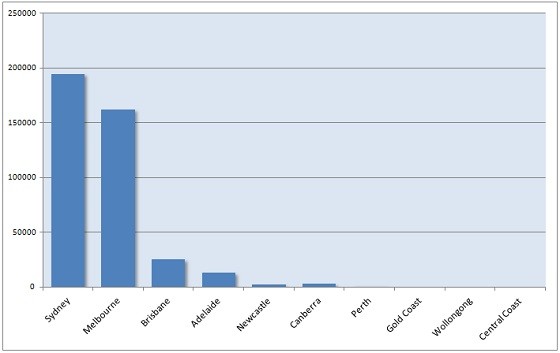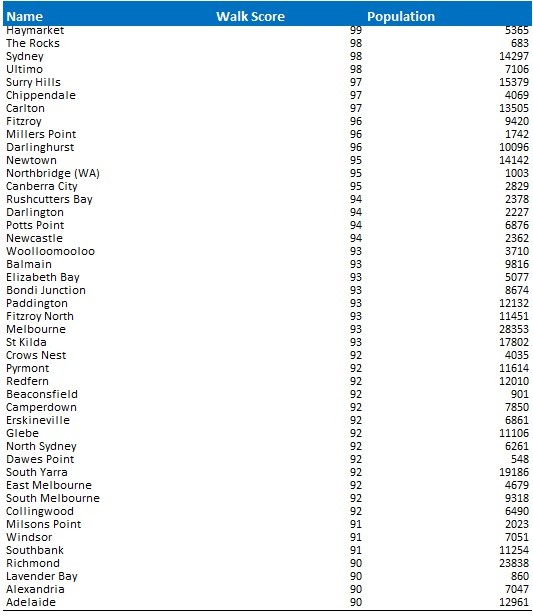
Sydney and Melbourne are by far Australia’s most walkable cities according to US company Walk Score, which released walkability rankings of Australia’s largest cities last week.
Walkability is a term much loved in planning circles. It summarises key urban qualities like density, design and diversity of uses. It extends the simple idea of compactness to also include connectedness and variety of destinations.
Sydney is the clear leader with an overall rating of 63 out of 100, followed by Melbourne with 57 and Adelaide with 53. Canberra’s at the bottom of the pile, with a score of just 40 – that puts it well behind the central counties of US ‘sprawl’ cities like Phoenix (45), Dallas (47), Houston (50) and Atlanta (53).
Sydney has 29 suburbs defined by Walk Score as a ‘walker’s paradise’ i.e. they each score 90 or higher. Melbourne has 12 suburbs that meet the criteria and Brisbane 5. Adelaide, Perth, Canberra and Newcastle only have one each.
The algorithm used by Walk Score essentially aggregates the number of amenities within walking distance of a point (e.g. an address). The amenities include “businesses, parks, theaters, schools and other common destinations.” More precisely:
It awards points based on the distance to the closest amenity in each category. If the closest amenity in a category is within .25 miles (or .4 km), we assign the maximum number of points. The number of points declines as the distance approaches 1 mile (or 1.6 km)—no points are awarded for amenities further than 1 mile.
The score at each point is weighted by the surrounding population density and then normalised to arrive at a suburban or city-level score.
It’s important to understand that the scores are approximations. They don’t take account of other factors that influence the desirability of walking in a particular city, like the steepness of hills, climate and crime risk.
Another limitation is the algorithm has no regard for the quality of proximate amenities – it weights them equally. A school is as important as a hardware store and a used car retailer. Further, it uses “as the crow flies” distances, not actual walk distances.
While they shouldn’t be taken too literally, especially at the level of specific addresses, Walk Score’s results are nevertheless consistent with what I would expect at the suburban and city levels.
They show the most walkable suburb in each city is Haymarket (Sydney), Carlton (Melbourne), Northbridge (Perth), Brisbane City, Canberra City, Newcastle City, and Adelaide City.
The average size of suburbs differs significantly between cities, so to get a better comparison I’ve calculated the number of residents who live in suburbs with a score of 90 or more (see first exhibit).
In Sydney, 194,885 residents or 5.6% of the metropolitan population live in a ‘walker’s paradise’ and in Melbourne it’s 162,347, or 4.5% of the metro population. The numbers are much smaller in other cities e.g. the next largest is Brisbane with 25,418, or 1%, living in suburbs with a score of 90 or higher.
Sydney also does better at more modest but still respectable walkability levels. 640,423 Sydneysiders (16.6%) live in suburbs with a score of 80 or more, compared to 386,550 in Melbourne (10.6%) and 98,651 in Brisbane (5.4%). Sydney performs better at the bottom end too – 80,961 residents live in suburbs with a Walk Score of less than 30, compared to 146,526 in Melbourne and 183,579 in Brisbane.
Compared to New York City, though, these numbers are paltry. NYC has an overall Walk Score of 85 and 2,966,608 of its 8,175,133 residents live in suburbs with a score of 90 or higher. (It would be misleading though to compare proportions, as NYC excludes the more populous outer suburbs of the New York metropolitan area). (fn 1)
Taken together, the suburbs with 90+ walk scores in Australian cities house just 380,219 residents (see second exhibit). They’re all located in the inner city, most of them close to the CBD. That has important implications for the policy objective of enhancing walkability across metropolitan areas.
Australia’s ‘walker’s paradise’ suburbs are highly walkable because they enjoy a very special set of conditions not easily replicated elsewhere, including:
- An existing stock of historical higher density housing mixed with former industrial, commercial and institutional buildings.
- Relatively high public transport density due to proximity to the focal point of the metropolitan radial public transport system
- Close proximity to the largest single concentration of jobs and consumer services in the metropolitan area
- A resident population, as well as a large number of daytime and night time visitors, with the wherewithal and the tastes to generate uses for non residential buildings
- High levels of traffic congestion and high parking costs that reduce the advantages of car ownership
Walkability is more than density – it also has regard for destinations and the journey itself. Strategies to promote walkability in other parts of metropolitan areas must recognise that most of the conditions supporting the high walk scores of the inner city are special.
They would be difficult to reproduce in another place, suggesting that achieving high levels of walkability in other locations like new fringe suburbs is a challenging objective. It requires a different and more imaginative way of thinking.

____________________________________________
(fn 1) Caution is needed in comparing Australian cities with the US cities in the Walk Score data base, as most of the latter cover only the central County or City, not the much larger metropolitan areas that are used to define the Australian cities.








Crikey is committed to hosting lively discussions. Help us keep the conversation useful, interesting and welcoming. We aim to publish comments quickly in the interest of promoting robust conversation, but we’re a small team and we deploy filters to protect against legal risk. Occasionally your comment may be held up while we review, but we’re working as fast as we can to keep the conversation rolling.
The Crikey comment section is members-only content. Please subscribe to leave a comment.
The Crikey comment section is members-only content. Please login to leave a comment.